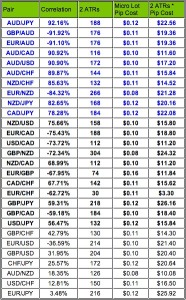Over the last 10 years of meeting clients, invariably most new client meetings start with questions regarding currency trends. During these initial meetings, I always understood that the questions have very little too do with any advice regarding forex, but more to do with my analysis. I usually discuss the basic fundamental relationships involved in the macroeconomic landscape, including central bank activities. Often, this acts as a basis for the client to launch into what he or she thinks will happen in the world. Its a fun and important discussion to have with new clients, as I learn about the client’s biases. This helps me understand his or her risk profile, investment time frame, rates of return expectations, and general knowledge of investments.
During later meetings forex questions often come up again. During these meetings we usually discuss trends in the EUR/USD pair, as its the main currency pair most clients are concerned with in terms of managing portfolio risk. However, there is so much more (and exciting) about forex! By the time we start discussing currencies like AUD, NZD and CAD, most clients realize they will never take a position in one of those currencies and the conversation ends pretty quickly.
As an advisor, I need to watch forex markets. Forex trading heavily influences stock and bond prices. It involves trading the largest, most liquid and highest leveraged instrument in the world. In order to establish a better basis to have more in-depth discussions with clients about currencies and their relationship with stock, bond and commodity prices, I want to share a two main pieces of information we watch on a regular (at least, quarterly) basis: currency pair correlations with the S&P 500 US equity index and currency pair trading ranges (volatility).
The accompanying table displays this data for the major currency pairs, ranking them in order of most correlated with the S&P 500. Right away, you can notice that the most liquid major currencies (EUR, JPY and USD) currently enjoy low correlation with the S&P 500 right now. On the other hand, currency pairs that contain AUD, NZD and to a lesser extent the CAD are strongly correlated with the S&P 500. These are often called the ‘risk on’ currencies that appreciate in value when macroeconomic optimism abounds. Understanding how ‘risk on’ currencies are performing relative to ‘risk off’ currencies is the first step determining market trends.
I watch more than just correlation levels. Clients should also if they want to diversify risk in their portfolios. Certain pairs trade in an ‘orderly’ fashion with each other, while others are less predictable. By knowing the ‘average true range’ (ATR) of the pair denominated in a single price (USD, for instance, here), I can discuss adding meaningful diversification elements to investment portfolios. According to the chart, it makes little sense to discuss the benefits of adding a EUR/CHF overlay to a portfolio, as the pair is basically tied at the hip. Discussing how the GBP, AUD and EUR will trade relative to the Japanese Yen seems worthy to discuss, as we can see from the high value of their movements in relation to each other.
Armed with this information, AVC’s advisors and clients have a genuine starting point to discuss adding currency positions to investment portfolios. For many clients, a currency overlay — possibly with an active trading manager — would add to investment returns.

